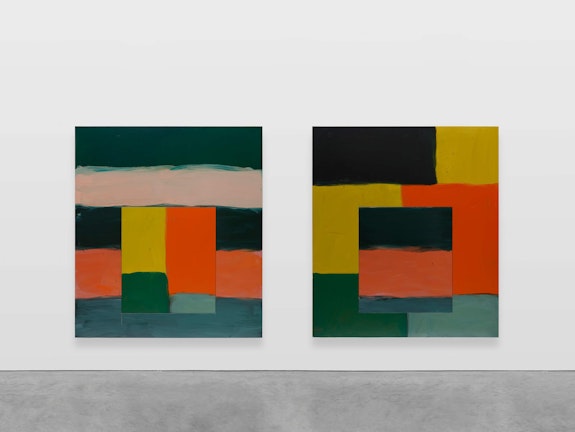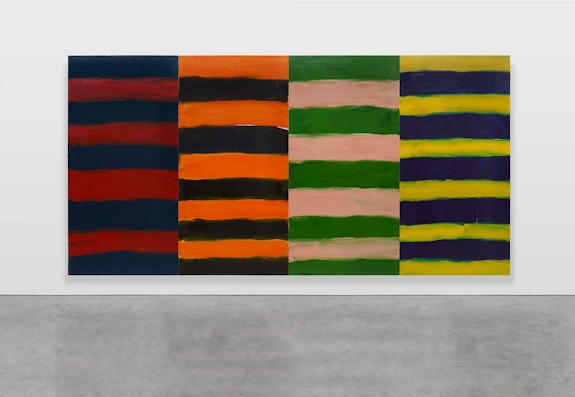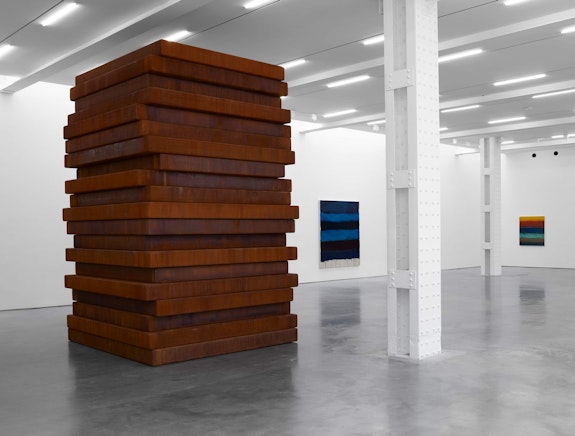ArtSeen
Sean Scully: PAN
On View
Lisson GalleryApril 30 – June 8, 2019
New York
I am not sure about the meaning of PAN, the title given to this exhibition by Sean Scully, but the Greek origin of the word would appear to suggest sexual prowess. On another level, it might serve as an indirect allusion to Hellenic architecture, which was influential on the formation of his signature style. While the title is not discussed in the gallery’s press release, I recall a film on the artist nearly twenty years ago where he practices karate in his studio. It appears this has been recently updated in the BBC production, Unstoppable: Sean Scully and the Art of Everything (April 2019). One might conclude that Scully’s overwhelming desire to release pent-up energy in one form or another is fitting for his inaugural exhibition in New York at the Lisson Gallery, historically known for introducing Conceptual art to London in the late 1960s.
While Scully is not “conceptual” in the sense of either Sol LeWitt or Robert Ryman—two artists he greatly admires, who were formerly shown at Lisson—the Irish-born painter began developing a grid-like approach to painting prior to the early 1970s when he first arrived in New York. Later that decade, his paintings turned dark gray with evenly spaced horizontal lines that would eventually lead to a more painterly style involving linear blocks of color, placed horizontally and vertically in the picture plane.
PAN is a two-gallery exhibition that clearly emphasizes the diversity of Scully’s achievement over the course of his career. In the Gallery’s 24th Street location, we are presented with a terse grouping of the various directions in abstract painting he has pursued since the early 1980s yet, the works included here, including the various Landlines, were all painted within the past year and a half. As a result, the quality of these works varies from the stylistic sources from which they are drawn. To know this depends on having seen paintings from earlier time periods either in museum collections or in exhibitions shown in past years throughout Europe and the United States (and more recently in Beijing).
For example, the highly prominent, four-panel, oil on aluminum painting, titled Shutter (2019), appears less complete than a similar group of paintings from four or five years ago where the strident horizontal felt more self-assured in relation to the tonality of the color. Shutter appears to function panel by panel instead of giving the eye a license to move through the painting and across it. The interruptions become too abrupt, as the choice of color often intercedes in a manner that breaks down the visual flow. In addition, the awkward placement of some bands weakens the counterpoint of spatial stability from one panel to the next.
On the other hand, Vice Versa Green (2019) takes another earlier idea from the mid-1980s and gives it an entirely new perspective. It is a brilliant two-panel oil on aluminum painting. Each panel measures 85 × 75 inches and is hung side-by-side with a space in-between. A smaller inset painting is wedged in the center of each panel. In doing so, the inset paintings appear to echo the abstract color and form of the larger panel beside it. The result of this complementary visual phenomenon is as clear as it is perplexing, as formal as it is conceptual. Finally, Vice Versa Green incites a holistic intensity that permeates the space within and around it.
The second venue of the exhibition continues at the 10th Avenue location (near 19th Street) where emphasis is given to Scully’s figurative works, both from the 1960s, and more recently from the past two years. The larger, recent paintings, again on aluminum, are titled Madonna (2019). The subject matter in these paintings includes a woman with a young boy (based on a photograph of the artist’s son). Another painting in this grouping, Boy Land (2019), predictably makes a case of formal resemblance between Scully’s abstract Landlines and his exploration of a larger-scale approach to figuration, here on two adjacent paintings. I find these paintings difficult to evaluate in terms of consistency given that the expressive content is, at times, difficult to grasp. The painterly resemblance is more accurate than the message the paintings attempt to portray.
The third modality of work shown in this highly ambitious exhibition is the artist’s sculpture. The two selected for this showing—one at each gallery—are Shadow Stack (2018) in Corten steel at the 24th Street venue and Ten Ton Ceiling (2017) in bronze and aluminum. Scully has retained a parallel involvement in working with modular form in sculpture for many years, which has evolved in a relatively consistent manner. This form might also be seen as a three-dimensional trace of what is present in his abstract paintings—a comment he made recently in a dialogue with the art critic Deborah Solomon at the Lisson Gallery—and suggests the aspect of ambiguity in Scully’s work. Clearly abstract painting is the source of what he does and is closest to how he thinks of himself as an artist. I would argue his sculpture is more connected to abstract painting than figuration, and will remain the inevitable direction of his work .




